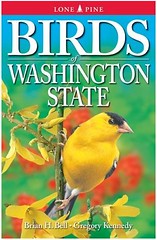 A bookseller in Seattle who was a friend of mine often told me that his customers really wanted a durable and reasonably-priced field guide that focused on Washington State birds and was targeted specifically to beginning, visiting and relocating birders. Finally, after years of breathless waiting, that book, Birds of Washington State, by Brian Bell and Gregory Kennedy was recently published (Auburn, WA: Lone Pine, 2006).
A bookseller in Seattle who was a friend of mine often told me that his customers really wanted a durable and reasonably-priced field guide that focused on Washington State birds and was targeted specifically to beginning, visiting and relocating birders. Finally, after years of breathless waiting, that book, Birds of Washington State, by Brian Bell and Gregory Kennedy was recently published (Auburn, WA: Lone Pine, 2006).
In short, Birds of Washington State is the most user-friendly bird field guide I've seen. It has a sturdy softcover that allows the user to quickly and easily flip through its pages in search of that one special bird, and the cover has a lovely illustration of an American goldfinch, Carduelis tristis, the state bird for Washington.
The book is 384 pages long and contains 320 species accounts for birds in 19 taxonomic orders, birds that are native to, or migrate through, Washington State. It also has an appendix that lists 33 more "occasional species" that show up every few years in the state. The species appear in the book according to the order suggested by the modern DNA-based phylogenetic relationships for birds instead of the traditional taxonomic classification scheme. This phylogenetic arrangement places those birds that are more similar to ancestral birds, the waterfowl and fowl, at the front of the book, followed by those that are progressively more derived (most different from ancestral birds), all of which appear further back in the book.
The main part of the book consists of species descriptions according to the format shown in the accompanying illustration (above; click image for larger view in its own window). Each page has one species account which includes a short descriptive passage about the species along with an attractive painting in the middle of the page, with a range map depicting seasonal distributions within the state, and a short overview of the specifics of identification; status in the wild; preferred habitat; nesting and feeding behaviors; a description of vocalizations; similar species and how to differentiate them; and the best locations in the state to find that species.
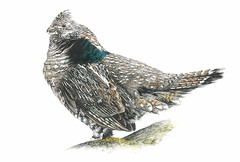 Species illustrations reveal the basic field marks that are used to identify most individual birds of a species, although the book does not depict the wide range of plumage pattern variations that one might observe when in the field. Thus, it is likely that advanced birders will wish to supplement this book with other, more detailed works.
Species illustrations reveal the basic field marks that are used to identify most individual birds of a species, although the book does not depict the wide range of plumage pattern variations that one might observe when in the field. Thus, it is likely that advanced birders will wish to supplement this book with other, more detailed works.
Written species descriptions are charming and easily understood, often using colorful non-technical terms that are intuitively obvious to beginners, terms such as "eyebrows". To encourage beginners to learn the proper vocabulary, scientifically accurate descriptive terms are often used as well, and are defined with a reference illustration in the glossary. Other especially appropriate learning aids for beginners are specific strategies and recommendations that make it easier to learn bird identification, such as conveniently color-coded family groupings at the beginning of the book that include a small picture and page number for each species.
Also included in the book is contact information for the primary birding organizations in Washington State, such as the major chapters of the Audubon Society, birding telephone hotlines and the web URL for the Tweeters email list, which is the finest birding email list in the world, both for the overall quality of the discussions and for the diversity of its contributors.
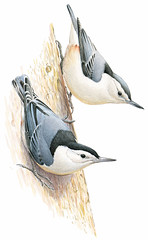 A number of useful indices can be found in the book too, including a checklist of all bird species that have been officially recorded in Washington State, a separate index listing scientific and common names, as well as discussions of important items for people who are just starting out, such as choosing your binoculars, where and when to find birds (habitat types and peak times of activity), a listing of birds seen, and other bird topics, such as bird feeding, conservation issues and information about West Nile Virus, etc.
A number of useful indices can be found in the book too, including a checklist of all bird species that have been officially recorded in Washington State, a separate index listing scientific and common names, as well as discussions of important items for people who are just starting out, such as choosing your binoculars, where and when to find birds (habitat types and peak times of activity), a listing of birds seen, and other bird topics, such as bird feeding, conservation issues and information about West Nile Virus, etc.
Even though I have mainly focused on those features that make this field guide well-suited to beginning bird watchers, Birds of Washington State will also prove to be a valuable addition to an established birder's field guide collection because its range maps are quite accurate, especially when compared against my own notes from the many years when I lived in and extensively birded the state.
Additionally, birders who are visiting Washington will enjoy this book because it includes a map showing the top 50 areas in the state to locate specific bird species. This map also illustrates basic vegetation zones and it is accompanied by extended treatments of the top 15 birding sites, representing a wide sample of the different habitat types throughout this habitat-rich state and the interesting bird species that can be seen in those areas.
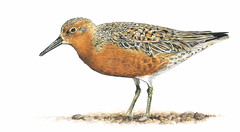 I highly recommend this field guide. It will help new birders to improve and enhance their observational skills, it provides valuable bird finding information to visiting bird watchers, and it refines the recent information available to established birders.
I highly recommend this field guide. It will help new birders to improve and enhance their observational skills, it provides valuable bird finding information to visiting bird watchers, and it refines the recent information available to established birders.
.
Brian Bell has watched birds for more than 30 years. A geographer and environmental & energy planner, he began birding while visiting project sites during preparation of environmental reports. Bell is the president of the Washington Ornithological Society and has served on its board of directors for eight years; he is the Seattle Audubon's field trip chair and a graduate of the Seattle Audubon's "Master Birder" course; and he teaches birding classes for both the Audubon Society and at several community colleges in the Seattle area. Bell has lived and birded extensively in California, Louisiana and Washington, and has traveled (and birded) throughout North America and Australia.
Gregory Kennedy is a lifelong naturalist and adventurer. He is the author of many natural history books and has produced film and television pieces about environmental issues and indigenous concerns in Southeast Asia, New Guinea, South and Central America and the high Arctic. His involvement in research projects around the world range from studies in the upper canopy of tropical and temperate rainforests to deepwater marine studies.
.

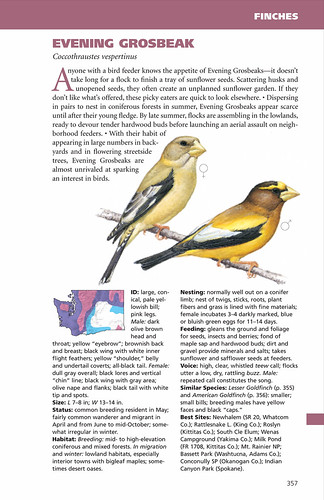
I am a graduate student and Washington state resident, and I just caught the birding bug this summer. I went out to buy the necessary equipment to get started, and I settled on this book for my first field guide. It has been a great reference for all of the reasons you describe above; the only problem is that it is beginning to get tattered from overuse!